Brief Summary of
Oarai International Symposium on Peaceful Use of Nuclear Energy
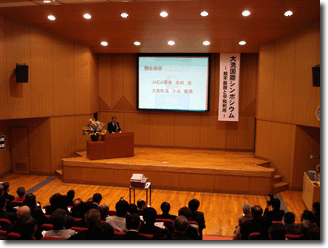
JAEA Nuclear Nonproliferation Science and Technology Center (NPSTC) held "Oarai International Symposium on Peaceful Use of Nuclear Energy" on 7 February 2006 at Oarai Research and Development Center. Approximately 160 people from Ibaraki Prefecture, government, nuclear utilities, press and universities participated in the Symposium. Mr. Ryo Kimura, JAEA Executive Director and Mr. Takaaki Kotani, Mayor of Oarai Town made the opening remarks of the Symposium.
Special Speech
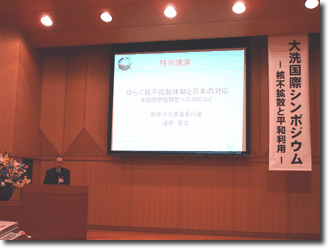
Ambassador Tetsuya ENDO, former vice-chairman of Japan Atomic Energy Commission, made a special speech titled "Recent Trends in Nuclear Nonproliferation." He reviewed nuclear nonproliferation history starting from the establishment of Nuclear Nonproliferation Treaty (NPT), North Korea's and Iran's noncompliant activities within the NPT, strengthening of IAEA Safeguards and export controls, and recently proposed nuclear nonproliferation frameworks, such as the Multilateral Nuclear Approach (MNA) by Dr. Mohamed ElBaradei of IAEA and Fuel Reserves by US President Bush. He also mentioned a new US nuclear energy initiative called "Global Nuclear Energy Partnership (GNEP)," which the US Department of Energy announced just a day before the Symposium. Learning from the history, he concluded that there is no "panacea" for nuclear nonproliferation; therefore, it is vitally important to further promote these frameworks given the current unstable NPT situation. Regarding Japan's position in these frameworks, the Ambassador emphasized that it is necessary for Japan to specially contribute to the strengthening of international nuclear nonproliferation regime by active participation in these frameworks, as the only nation bombed with nuclear weapons in the world, while establishing the nuclear fuel cycle for its own energy security.
Presentation of Policy Research in NPSTC
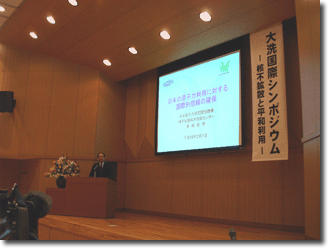
After the speech, two nuclear nonproliferation policy researches, which have been conducted by Policy Research Office of NPSTC, were presented by Mr. Takaaki KURASAKI and Mr. Keiichiro HORI.
Mr. Takaaki Kurasaki, General Manager of NPSTC Policy Research Office, focused on how Japan has achieved international confidence in its nuclear fuel cycle activities in his speech titled "International Confidence to Nuclear Activities in Japan." After emphasizing Japan's long term and sincere efforts for safeguards implementation, he concluded that Japan can contribute to the enhancement of international nuclear nonproliferation regime by disseminating Japanese style safeguards efforts to the world as the "best practice" of safeguards implementations.
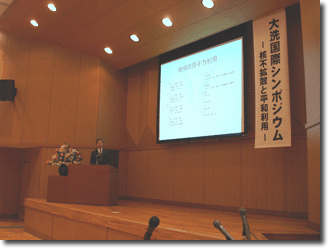
Another nuclear nonproliferation policy research entitled "Enhancing Transparency in Nuclear Activities in Asia" was presented by Mr. Keiichiro Hori, Senior Principal Engineer of NPSTC. He pointed out that transparency is a key to promote peaceful use of nuclear energy in Asia, considering the increase of energy demand, as well as expansion of nuclear energy utilization in this region. There are regional nuclear cooperation frameworks, such as ASEAN, ARF, FNCA and CSCAP, so transparency can proceed step-by-step by introducing various transparency measures (information exchange, information disclosure and regional inspection) within these proposed frameworks.
Panel Discussion
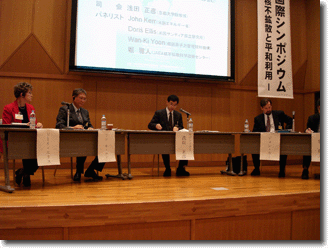
Policy research presentations were followed by a Panel Discussion titled "Transparency and its Technology in Nuclear Activities." Mr. John KERR of US DOE National Nuclear Security Administration (NNSA), Ms. Doris ELLIS of US Sandia National Laboratories (SNL), Dr. Wan Ki YOON of the National Nuclear Management and Control Agency (NNCA) of Korea and Mr. Masato HORI of JAEA/NPSTC participated in the Panel as panelists. Prof. Masahiko ASADA, Kyoto University served as the moderator.
At the beginning of the Panel, Mr. John Kerr presented new US nuclear nonproliferation initiatives, which are known as "Fuel Reserves" and GNEP. Mr. Masato Hori pointed out that these approaches are preferable from the perspective of efficient use of energy resources, reduction of wastes and nuclear nonproliferation; however, due to the issues on nuclear facility siting, safeguards, etc., it is important for US to cooperate with France and Japan, which have significant experience in these areas. Dr. Wan Ki Yoon also informally endorsed the initiatives, but cautioned that careful consideration will be required on the fuel supply to countries that abandon enrichment and reprocessing programs, because each country has a different nuclear policy.
As for India-US cooperation, Dr. Wan Ki Yoon pointed out that India's accession to NPT is the first priority, while Ms. Doris Ellis mentioned that India's disclosure of its civil nuclear activities and application of safeguards will be important as measures to bring India within the nonproliferation community.
All panelists agreed that regional and global cooperation, confidence building and transparency are very much required in future cooperation.
Regarding transparency in Asian nuclear activities, the US, Korea and Japan's efforts for transparency using remote monitoring technologies were presented by Ms. Doris Ellis, Dr. Wan Ki Yoon and Mr. Masato Hori. This included a demonstration of remote monitoring between JAEA's Joyo Experimental Reactor and SNL and Idaho National Laboratory in the US. Dr. Wan Ki Yoon pointed out that there is a difference between transparency for safeguards and transparency for confidence building and suggested that remote monitoring with inexpensive devices may be sufficient to achieve the latter transparency. In this context, he mentioned the importance of Korea - Japan cooperation on remote monitoring. Mr. Masato Hori agreed with Dr. Wan Ki Yoon and added the possibility of enhancing remote monitoring cooperation in Asia, if Japan and Korea can develop their cooperation as a model for transparency. Mr. John Kerr also agreed by saying that Asian countries may join the cooperation once the model cooperation, including the US, is established. Furthermore, Ms. Doris Ellis pointed out that transparency using remote monitoring can reduce the intrusiveness and cost of inspections, as well as improving timeliness and efficiency.
At the end of the panel, Prof. Masahiko Asada summarized as follows;
- There is now greater uncertainty about the nuclear nonproliferation regime, however, confidence building and transparency is a key to any cooperation in nuclear nonproliferation,
- Technologies that contribute to enhanced nuclear transparency, such as remote monitoring, are also useful for confidence building,
- It is important to expand nuclear transparency cooperation through remote monitoring, not only among Japan, Korea and the US, but also among other Asian countries step-by-step, and
- Further discussion among Asian countries is also important for nuclear transparency and confidence building in the region.
The Symposium was closed by remarks by Mr. Takashi Nagata, Director of JAEA Oarai Research and Development Center.
